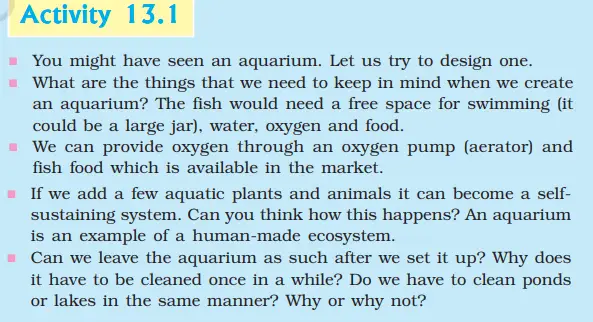Activity 13.1: Ncert book Science class 10
Activity 13.1 from the Class 10 Science NCERT book introduces students to the concept of ecosystems through the creation of a human-made aquatic ecosystem – an aquarium. This activity engages students in practical learning. It also encourages critical thinking about the complex balance of life within an ecosystem.

Activity 13.1 Class 10 Science: Creating and Understanding an Aquarium Ecosystem
The theory behind this activity
The theory behind this activity is the concept of an ecosystem, which is a complex network of interactions among organisms and between organisms and their environment. In an ecosystem, every organism has a role to play, and every element, whether biotic (living) or abiotic (non-living), is crucial for the system’s balance.
In the case of an aquarium, it is a human-made ecosystem, often referred to as a microcosm of a larger aquatic ecosystem. Here are the key theoretical concepts involved:
- Interdependence: The fish, plants, and other organisms in the aquarium depend on each other for survival. The fish produce waste, which provides nutrients for the plants. In turn, the plants produce oxygen, which the fish need to breathe.
- Energy Flow: The fish food represents the input of energy into the system. The fish consume this food and convert it into energy for growth and movement. When the fish excrete waste or die, they become food for bacteria and other microorganisms, transferring the energy further.
- Nutrient Cycling: The waste produced by the fish and other organisms is broken down by bacteria, releasing nutrients back into the water. These nutrients are then used by the plants for growth, completing the nutrient cycle.
- Balance: For the aquarium to be a self-sustaining system, it needs to have a balance of organisms and resources. Too many fish could deplete the oxygen levels and produce too much waste, while too many plants could use up all the nutrients.
- Maintenance: Unlike natural ecosystems, which are vast and have complex mechanisms for dealing with waste and maintaining balance, an aquarium is a small, closed system that needs human intervention for cleaning and maintenance. This is because waste can build up over time and become toxic for the organisms in the aquarium.
By setting up and maintaining an aquarium, students can observe these theoretical concepts in action, gaining a deeper understanding of how ecosystems work.
Aim
The main objectives of this activity is to learn about ecosystems by designing and to find out if an aquarium needs regular cleaning and other maintenance.
Materials Required for Activity 13.1 Class 10 Science
To carry out this activity, we need the following materials:
- A large jar or tank that provides ample space for fish to swim.
- Water, preferably dechlorinated, to fill the tank.
- An oxygen pump, also known as an aerator, supplies the necessary oxygen for the fish.
- Fish food, which can be easily procured from a pet store.
- A selection of aquatic plants and animals to create a self-sustaining system.
Procedure
The procedure for setting up an aquarium is as follows:
- Fill the large jar or tank with dechlorinated water.
- Install the oxygen pump in the tank to ensure a continuous supply of oxygen.
- Introduce the fish into the tank and provide them with the necessary fish food.
- Add a few aquatic plants and animals to the tank. These organisms will contribute to the balance of the ecosystem within the tank.
Cleaning and maintenance
Regular cleaning is crucial to maintain a healthy aquarium environment. This is because the decomposition of wasted substances, dead plant pieces, and fish excretory waste accumulates in the water as time passes. As these particles accumulate, the concentration of nitrogenous waste and unwanted microbes rises which could be harmful to fish.
Maintenance involves removing algae, replacing a portion of the water (20 to 30%), and cleaning the tank walls. We should not remove all of the water at once because it disrupts the aquatic ecosystem and kills some bacteria that are beneficial to fish.
The filter system should be checked and cleaned periodically to ensure efficient operation. Monitor water parameters like pH, temperature, and nitrate levels regularly. Overfeeding should be avoided as it leads to waste accumulation.
Observations
Once the aquarium is set up, students can observe several things:
- Fish, plants, and other organisms interact with each other and their environment. This interaction is a fundamental characteristic of an ecosystem.
- Over time, the aquarium may require cleaning. This is because waste materials build up in the tank, which can harm the fish and other organisms.
- We can easily create an aquarium using aquatic plants, animals, an aerator, a water tank, and other items. This ecosystem is not self-sustaining, and we must clean and maintain it on a regular basis.
Conclusion
From this activity, we can conclude:
- An aquarium is a human-made ecosystem that requires careful planning and maintenance to ensure the health and survival of its inhabitants.
- This is unlike natural bodies of water like ponds or lakes, which have larger, more complex ecosystems that can naturally handle waste materials.
- Small ecosystems created by humans may not be self-sustaining; they require routine maintenance.
